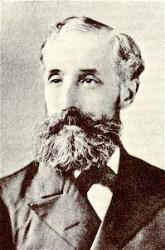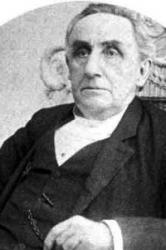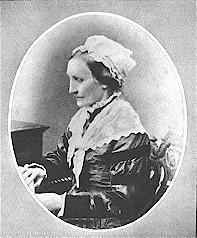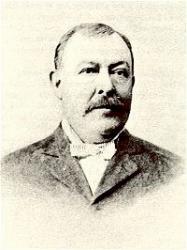Planning worship?
Check out our sister site, ZeteoSearch.org,
for 20+ additional resources related to your search.
- |
User Links
Person Results
‹ Return to hymnal






Export as CSV
F. R. Crane
Hymnal Number: 33 Composer of "[Like Jesus! what a wonderful promise]" in Epworth Praises
F. R. Crane
A. L. Peace

1844 - 1912 Person Name: Albert L. Peace Hymnal Number: 250 Composer of "[O Love that wilt not let me go]" in Epworth Praises Albert Lister Peace DMus United Kingdom 1844-1912. Born at Huddersfield, Yorkshire, England, son of a warehouseman and woolstapler, he was extremely gifted as a musician, largely self-taught, playing the organ at Holmfirth Parish Church near Huddersfield at age nine. He married Margaret Martin Steel Gilchrist, and they had three children: Lister, Archibald, and Margaret. In 1865 he was appointed organist of Trinity Congregational Church in Glasgow, Scotland. He obtained his doctorate degree from the University of Oxford in 1875. He became organist at Glasgow Cathedral in 1879. In 1897 he succeeded William Best as organist at St George’s Hall, Liverpool. In later years he was in much demand to play the organ in recitals. He did so at Canterbury Cathedral (1886), Victoria Hall, Hanley, Stoke-on-Trent (1888), and Newcastle Cathedral (1891). He composed orchestrations, sonatas, cantatas, and concert and church service anthems. He was an arranger, author, and editor. He died at Blundelsands, Liverpool, England.
John Perry
A. L. Peace
John T. Grape
1835 - 1915 Hymnal Number: 210 Composer of "[I hear the Savior say]" in Epworth Praises John Thomas Grape USA 1835-1915. Born at Baltimore, MD, he became a successful coal merchant. He married Sophia F MacCubbin, and they had one daughter, Agnes. He was a member of Monument St. Methodist Church in Baltimore, where he played the organ, directed the choir, and was active in the Sunday school. Later, he directed the choir at the Hartford Avenue Methodist Church. The hymn noted below was composed by Grape in 1868, with lyrics composed by Envina Mable Hall of the same church in 1865 while sitting in the choir loft during a sermon. Both words and music had been given to the pastor, Rev George W Schreck, at different times, and one day he remembered he had been given both. Grape's tune had a refrain, so Ms Hall, hearing it, then added words to her poem for that, and the hymn was complete. At Schreck's urging they sent the hymn to Professor Theodore Perkins, publisher of “Sabbath Carols” periodical, and it became popular. Grape died in Baltimore.
John Perry
John T. Grape
Philip Phillips

1834 - 1895 Hymnal Number: 63 Composer of "[I will sing you a song of that beautiful land]" in Epworth Praises Phillips, Philip, commonly known as the "Singing Pilgrim," was born in Chautauqua County, N. York, Aug. 13, 1834. Although engaged in farming for a time, from an early age he devoted himself to music, and ultimately devoted himself to the work of a "Singing Evangelist," in which capacity he has visited most English-speaking countries. His popular hymnals are: (1) Early Blossoms, 1860; (2) Musical Leaves, 1862; and (3) The Singing Pilgrim, 1866. In these works he published one or two hymns, including "I have heard of a Saviour's love" (The love of Christ), as in I. D. Sankey's Sacred Songs and Solos, 1878.
--John Julian, Dictionary of Hymnology, Appendix, Part II (1907)
Philip Phillips
E. H. Stokes

1815 - 1897 Hymnal Number: 55 Author of "Fill Me Now" in Epworth Praises He was president of the Ocean Grove Campmeeting Association.
E. H. Stokes
Mrs. Catherine J. Bonar

1821 - 1884 Person Name: Mrs. Catharine J. Bonar Hymnal Number: 237 Author of "Jesus Is Mine" in Epworth Praises Bonar, Jane Catharine, née Lundie, daughter of the Rev. Robert Lundie, some time minister of the parish of Kelso, born at Kelso Manse, December, 1821, married, in 1843, to Dr. H. Bonar, and died in Edinburgh, Dec. 3, 1884. Her hymns appeared in Dr. Bonar's Songs for the Wilderness, 1843-4, and his Bible Hymn Book, 1845. Their use is very limited. Mrs. Bonar is chiefly known through her hymn:—
Pass away, earthly joy. Jesus, all in all, which appeared in the Songs for the Wilderness, 2nd Series, 1844, and again in the Bible Hymn Book, 1845, No. 108, in 4 stanzas of 8 lines, including the refrain, "Jesus is mine!" The original text is given in Dr. Hatfield's Church Hymn Book. 1372, No. 661. Sometimes this is altered to "Fade, fade, each earthly joy," as in the American Songs for the Sanctuary, 1865, No. 114, and others. The last stanza of this hymn is also st. iv. of the cento, "Now I have found a friend," &c. (q. v.)
-- John Julian, Dictionary of Hymnology (1907)
Mrs. Catherine J. Bonar
William G. Tomer
1833 - 1896 Person Name: W. G. Tomer Hymnal Number: 96 Composer of "[God be with you till we meet again]" in Epworth Praises Born: October 5, 1833, New Jersey.
Died: September 26, 1896, New Jersey.
Buried: Union Cemetery, Finesville, New Jersey.
Tomer studied singing and sang in the choir in Finesville, New Jersey, and began teaching school at age 17. He served in the Union army during the American civil war, then worked as a clerk in Washington, DC, served as music director for Grace Methodist Episcopal Church, and taught school in New Carpentersville and Greenwich, New Jersey. He was living in Greenwich as of 1880.
--www.cyberhymnal.org/
William G. Tomer
Theodore E. Perkins

1831 - 1912 Person Name: T. E. Perkins Hymnal Number: 237 Composer of "[Fade, fade, each earthly joy]" in Epworth Praises Theodore E. Perkins was born at Poughkeepsie, on the Hudson, N.Y., July 21, 1831. His father was a Baptist clergyman. The family of ten brothers and sisters sang and played various instruments, forming among themselves both choir and orchestra. His musical education began at the early age of three years. During his father's pastorate at Hamilton, N. Y., the choir rehearsals were often held at the parsonage, and the leader used to place the three-year-old on a small stool, on the table around which the choir was assembled, giving him a chance to both see and hear. Later on he played the violincello in church, standing on a stool in order to finger the instrument.
The home gatherings — especially on Thanksgiving Day, are the recollections among the happiest of his childhood. His father became pastor of the Berean Baptist Church in New York City, in 1839, giving him the opportunity of studying the pianoforte, of which he became a proficient player. His fine alto voice soon gave him notoriety. At the age of nineteen while filling a position as clerk in New York, all his spare time was given to the study of voice and piano. In 1851 he went to Hamilton, N. Y., taught music in Madison University (now Colgate), and in the Female Seminary.
In 1854 he went to Port Jervis, N. Y., where he taught singing school, and April 30, 1855, married Mary Frances Caskey, who was for years his soprano soloist in many musical Festivals and Conventions. Soon after marriage he removed to Salem, N. J., where his lifework as singing school teacher really began, including Bridgeton and prominent towns in southern New Jersey. During the summer of 1856 he and his wife were pupils of the Normal Academy of Music at North Reading, Mass., conducted by Drs. Lowell Mason and Geo. F. Root. During 1856-1858 he was given the position of assistant teacher and manager. His association with these two great men gave an inspiration to all his future work.
In 1859 he was co-principal with Wm. B. Bradbury at the Normal Academy of Music, Geneseo, N. Y. He remained at Geneseo until 1863. Professor Perkins also held very successful schools in North Pelham Province of Ontario, Canada, and in 1864-1868 was principal in schools at Tunkhannock and Meadville, Pa.
In 1860, The Olive Branch, his first book of church music, was published by F. J. Huntington, New York City, the sales reaching 100,000. Next was Oriental, which sold over 30,000. The Union, Glees and Anthems, and Sabbath Anthems followed ; then The Sacred Lute, which sold over 300,000. His Sunday-school books commenced with The Evergreen, followed by the Shining Star and New Shining Star. Then came Psalm King, which was the last of the books published by Mr. Huntington. Hallowed Songs was published by Philip Phillips; The Sunday School Banner was published by Wm. B. Bradbury. The Royal Standard was published in Toronto, Canada. The Golden Promise, Sabbath Carols, The Mount Zion Collection were published under his own supervision.
His Free Sunday School Songs several times numbered over 500,000 a month. Coronation Songs with Rev. Dr. Deems as hymn editor was published by A. S. Barnes Co., who also published Psalms and Hymns and Spiritual Songs, in which Dr. C. S. Robinson was hymn editor, who with Professor Perkins edited Calvary Songs, published by the American S. S. Union. Gospel Tent Songs was evangelical. The Safe-Guard Singer was his temperance book.
Mr. Perkins was musical director in the following churches in Brooklyn: The Lafayette Avenue Presbyterian Church, Rev. Dr. Cuyler; Strong Place Baptist Church, Rev. E. E. L. Taylor, D. D.; Madison Avenue Baptist Church, Rev. H. G. Weston, D. D., L. L. D.; Fifth Avenue Presbyterian Church, Rev. Dr. Rice, followed by Dr. John Hall; The Memorial Presbyterian Church, Rev. Dr. C. S. Robinson, who was his close friend; The Church of the Holy Trinity, Rev. Dr. Tyng, Jr. ; Trinity Baptist Church, Rev. Dr. J. B. Simmons, and Washington Square M. E. Church.
In Philadelphia: The Fifth Baptist Church, Rev. Dr. Chase; The Eleventh Baptist Church, Rev. Dr. Colman; The Tabernacle M. E. Church, Rev. George Gaul, D. D. He was leader and singer in Evangelistic Services, at the Rink, The Old Madison Square Garden and Cooper Union, all of New York City. The music of the first great meeting of the world's Evangelical Alliance, held for ten days in New York City, was under his direction, as was the first National Sunday School convention, held in Newark, N. J. He was also conductor at the Golden Anniversary of the Female Guardian Society, leading a chorus of forty-two hundred children. In the opening chorus, Great is the Lord, by Dr. Calcott, the word "Great" was given with so much decision and power that the clergymen on the platform sprang to their feet and remained standing until the chorus was finished.
He taught voice culture in Princeton and Lafayette Universities, The Union Theological Seminary, New York City; Crozer Seminary, Chester, Pa., and organized the music department of Temple University, Philadelphia, continuing in charge four years. He had charge of the children's choir of Howard Mission, New York City, for twenty-five years, and thinks that some of the happiest and most restful of the working hours were spent in teaching the poor children of the fourth and sixth wards to sing the Gospel. Mr. Sankey said to Mr. Perkins that " Jesus of Nazareth was my banner song for eight years." Jesus is Mine has been sung at the Christian's death-bed, the grave, and once as the convict was going to the scaffold.
His Christmas Carol Sweetly Carol had a very large sale in this country, and was republished in England, France, Italy, and Germany.
For a period of forty years he has made the study of the voice special work. The most thorough investigations of the voice and its possibilities were made with the assistance of the late John Howard, extending over a period of twenty-five years, during which he has had the care of over two thousand voices. He published a work entitled, Physiological Yoice Culture, edited by his son, the late T. Edward Perkins, M. D., physician and throat specialist of Philadelphia. Mr. Perkins also completed a method of voice culture based on the principles of John Howard's Physiology of Artistic Singing."
During these years of work he has found time to edit thirty-four books of church, Sunday-school, day-school, and glee music, the larger portion having been previously mentioned. Also songs and ballads in sheet form, and a cantata entitled, The Excursion, libretto by Fanny Crosby, with whom there has existed an unbroken friendship for over forty years.
-Biography of Gospel Song and hymn Writers
Theodore E. Perkins
Alfred J. Hough
1848 - 1922 Person Name: Rev. Alfred J. Hough Hymnal Number: 18 Author of "Holding On to Jesus" in Epworth Praises Born: Circa November 1848, Surrey, England.
Hough, a minister, was living with his family in Ludlow, Vermont, by 1880, and in Hartford, Vermont, in 1900. He became a naturalized American citizen in 1890. His works include:
Solomon’s Song Re-Sung
Odd Fellowship in Song: Five Famous Poems, 1888
Egyptian Melodies, and Other Poems (Boston, Massachusetts: The Gorham Press, 1911)
--www.hymntime.com/tch
Alfred J. Hough
George C. Hugg

1848 - 1907 Person Name: Geo. C. Hugg Hymnal Number: 218 Composer of "[There's not a friend like the lowly Jesus]" in Epworth Praises George Crawford Hugg USA 1848-1907. Born near Haddonfield, NJ, he became choirmaster at the Berlin, NJ, Presbyterian Church at age 12. At age 14 he published his first song, “Walk in the light”, which became very popular. He married Anne E Ketchum, and they had a daughter, Evangeline. He served as choirmaster of the Tabernacle Presbyterian Church in Philadelphia, and also the Broad Street and Arch Street Methodist Episcopal Churches there. He was also closely associated with the Harper Memorial Presbyterian Church there. He was a prolific composer with over 2000 works, publishing 18 books of revival and Sunday school music, and 90 songs for special occasions (Christmas, Easter, etc.). He died in Philadelphia, PA.
John Perry
George C. Hugg


 My Starred Hymns
My Starred Hymns


